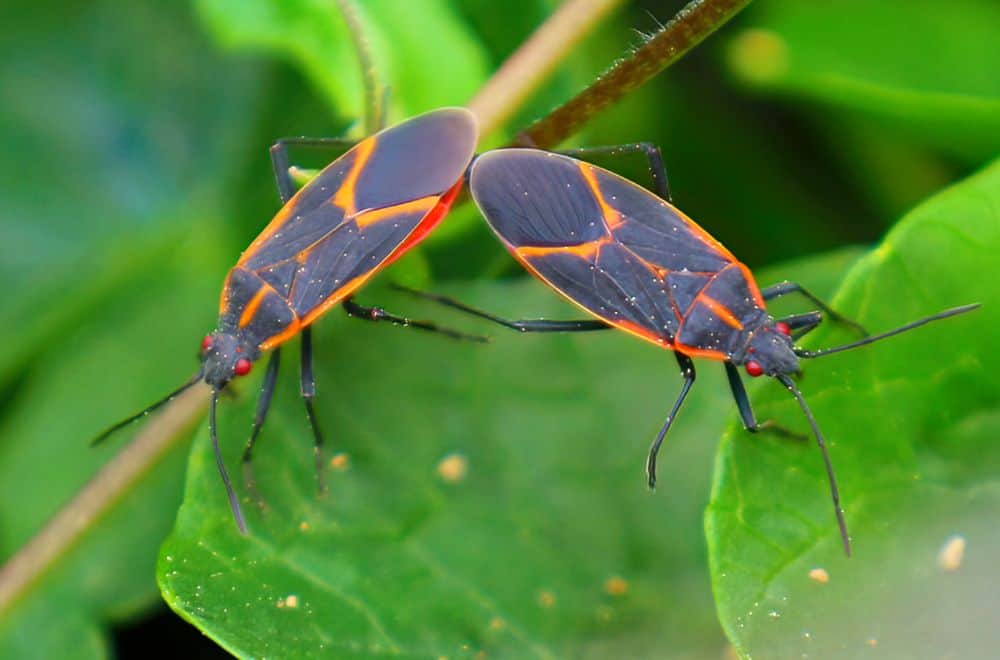Every year, boxelder bugs emerge from their hiding places to breed in great numbers, and sometimes, their populations can get out of control. Worse, if you’re not careful, they can even infest your home, in which case they can be very difficult to deal with.
But what are these bugs? Where do they come from? And why do they swarm over your property in such vast numbers? To help you understand questions like these and more, in this post we give you all the info you need about how to get rid of boxelder bugs.
What are boxelder bugs?
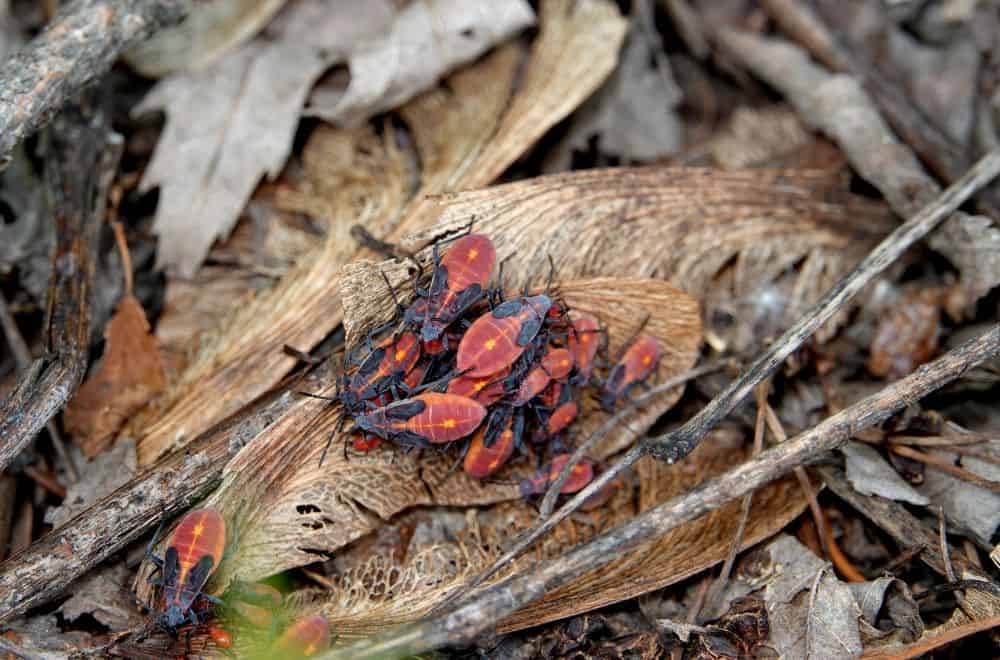
Before we talk about how to get rid of boxelder bugs, let’s say a few words about what they are so we know what we’re dealing with.
Boxelder bugs are a type of “true bug” belonging to the Hemiptera order.
They are not considered a species of stink bug, belonging instead to the Rhopalidae, a family known as the “scentless plant bugs”. However, like stink bugs, they can still produce a pungent foul smell as a defense mechanism or when crushed.
Their common name comes from their dependence on the boxelder tree, a type of maple. Their preferred food is the seedpods of female boxelder trees, although they can also survive on other maple species as well as on ash trees.
Adult boxelder bugs are about half an inch long. They are mostly black but have distinctive red markings on their backs. A single line runs down the top of the back from the head while there are other red lines on either side of the wings and at the base of the wings.
You may also see their eggs, which are yellow and are mostly laid in clusters on boxelder seed pods. They change from yellow to red as they develop.
In the various nymph stages, they look like smaller versions of the adults but are entirely red – and they become increasingly red with each successive molt.
Their natural range is the western portion of the United States, but they are now found in most parts of North America wherever boxelder trees are present.
What damage do they do and are they dangerous?
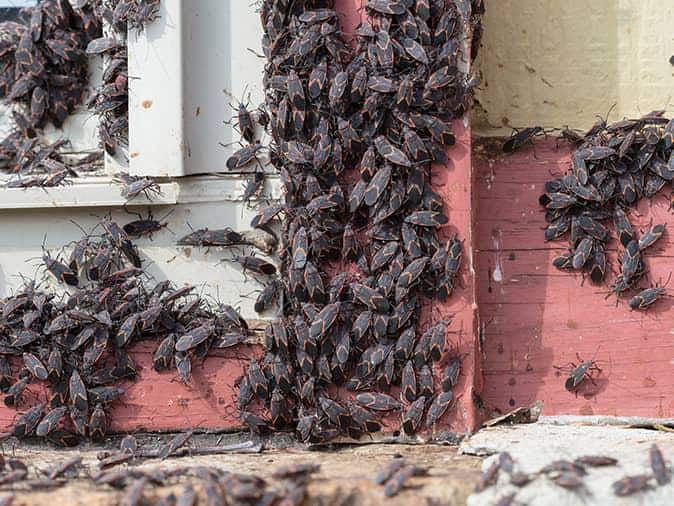
Image Credit: arrownj
Although these bugs possess a long proboscis that can pierce human skin, causing a small red mark and a slight itch on the rare occasions they bite, they are not considered dangerous to humans.
Rather, they are seen as a pest species that is unwelcome due to the bugs’ tendency to congregate in great swarms during both spring and fall – as well as their habit of overwintering in homes when they can make their way inside.
Although they can sometimes eat fruit such as apples, pears, peaches, cherries, grapes, strawberries and plums, superficially damaging the fruit, they prefer to eat boxelder seeds and sometimes leaves, so this is rarely a problem.
Instead, the issues they cause outside are more related to the size of the swarms they form when they emerge in spring to breed and then again in fall as they try to gain access to homes for overwintering.
During spring and summer, large numbers of them can collect on south- and west-facing sides of homes as they warm themselves in the sun, something that can become a frustrating eyesore for homeowners.
As winter arrives, if they manage to infest a home, they will then hide out in the wall spaces during the colder months, and in sufficient numbers, they will create a noticeable unpleasant odor.
Their feces can also stain curtains, clothes and other fabrics, and when you turn the heating on, it may fool them into thinking summer has arrived, causing them to emerge from their hiding places in search of food in your home.
So in short, while they don’t pose any significant risks to human health or safety, an infestation of these bugs, either in your yard or inside your home is most unwelcome.
The boxelder bug lifecycle
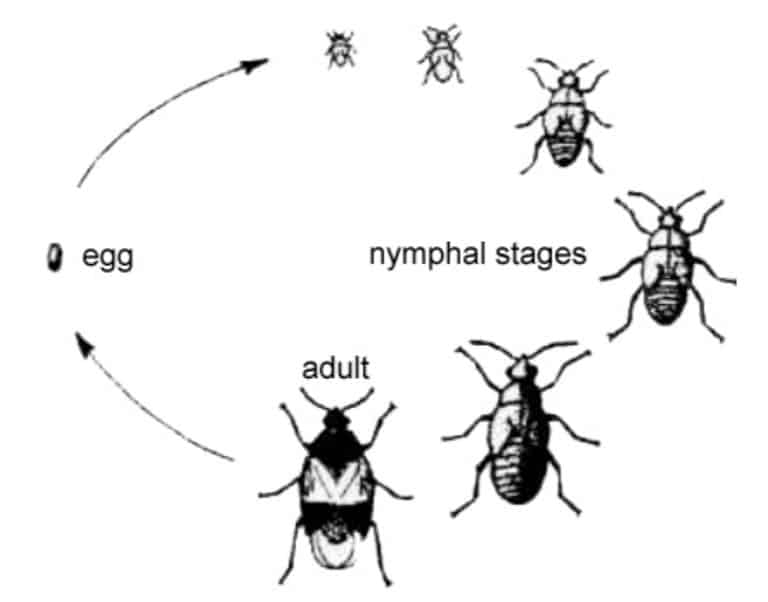
Image Credit: pestsguide
In a moment, we’re going to look at dealing with infestations once they start, but we’re also going to talk about how to prevent them from happening, which can be a simpler and more effective strategy.
But before we do that, we need to talk briefly about the lifecycle of boxelder bugs, because that will help us understand how to reduce the population of these bugs before they get out of hand.
Adult boxelder bugs spend the winter hiding out in gaps in bark, in leaf piles or anywhere else safe and warm – which also includes inside human habitations.
Then, as the weather begins to warm up in spring, they emerge en masse to mate and then lay eggs.
The females prefer to lay their eggs on the seed pods of boxelder trees, although they can lay them on other parts of the tree – or on the seedpods or elsewhere on other species of maple or ash.
After around 10-14 days, the eggs hatch and the nymphs emerge to begin feeding – again, on boxelder seed pods if they have the choice.
Nymphs molt several times as they develop into adults, and the insects continue to breed and lay eggs throughout the summer.
Then, as the temperatures drop, any nymphs that haven’t reached the adult stage die off, and the remaining adults search for places to spend the winter, often congregating in large swarms as they do so.
What to do about boxelder bugs swarms outside
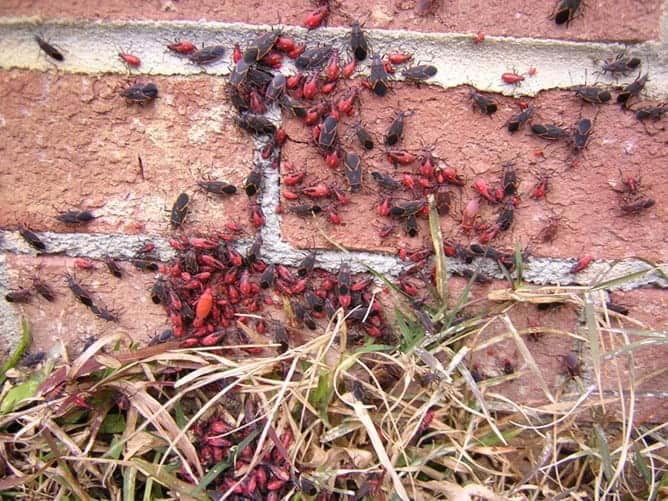
Image Credit: pestworld
If you are already facing swarming boxelder bugs outside, there are several things you can try to reduce their numbers. Here are some of your options.
1. Use diatomaceous earth
One of the safest and most effective treatments you can use on boxelder bugs is diatomaceous earth. This powder is harmless to humans and pets, but it destroys the exoskeletons of bugs, causing them to die.
You can use it by spreading it around the bottoms of any boxelder trees or anywhere else these bugs are congregating.
2. Use borax
A slightly more aggressive and toxic option is to use borax powder. You can use it in the same way as diatomaceous earth, but it’s probably best to avoid this if you have kids or pets.
3. Spray them with soapy water
Water mixed with regular detergent is a surprisingly effective anti-pest option that works by blocking up the holes insects breathe through, suffocating them to death.
Simply mix up some detergent such as dish soap with some warm water and then spray it over the bugs. If you repeat this several times over the course of a few days, you will notice the bug population declining.
4. Pour boiling water over them
Another option is to throw boiling water over the bugs. This might work by killing lots of them if they are swarming over the walls of your home – but be careful when you do it since you might end up scalding yourself with the water.
5. Suck them up with a shop vac
If you have a shop vac or at least a vacuum cleaner with a tube attachment, you can try using that to quickly reduce the population. After sucking the bugs up, seal the vacuum bag securely and dispose of the bugs to prevent them from returning.
6. Spray them with jets of water
Sometimes spraying large swarms of bugs on your walls with a powerful jet from a garden hose may be enough to encourage them to leave your home and go elsewhere.
7. Use insecticide
You can also turn to commercial insecticide, although this is not recommended if you have kids or pets due to the toxic chemicals they contain.
What to do about boxelder bugs inside
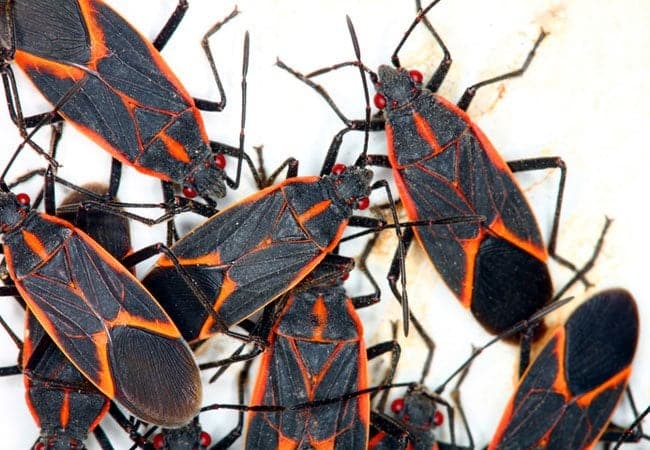
Image Credit: bobvila
If you notice large numbers of boxelder bugs in your home after the winter has already arrived, there’s not a lot you can usefully do.
Once inside, the bugs will hide out in your walls and other inaccessible spaces, and if you use insecticide to kill them, their bodies will remain in the wall cavities, attracting other pests such as carpet beetles and rodents, which may be worse than the boxelder bugs themselves.
The best advice is to try to vacuum up as many of the bugs as you can and leave the rest where they are. They won’t breed during the winter, so the infestation won’t get worse, and they won’t do too much damage to your home compared to other pests.
Of course, sharing your home with boxelder bugs over winter is far from ideal, which is why it’s vital to prevent them from entering your home in the first place, so let’s look at what you can do to stop the infestation before it starts.
How to reduce populations and limit swarms
Far better than dealing with swarms or infestations is preventing the bugs from congregating in the first place. Here’s what you should do both outdoors and indoors.
Outdoors
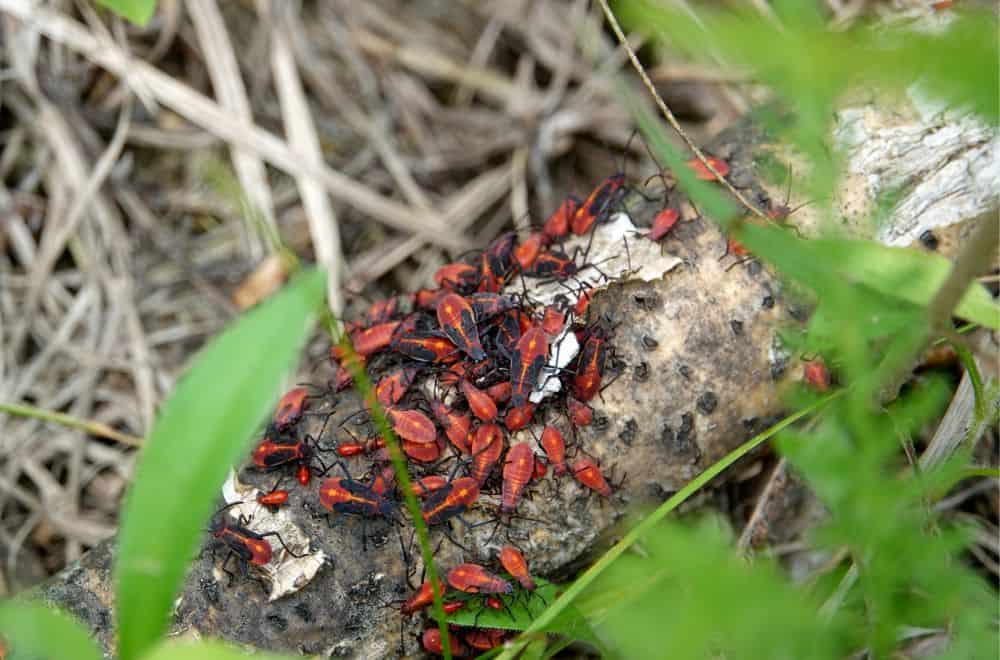
If you take the correct actions outdoors during the spring and the summer, there will be fewer boxelder bugs around by the time winter arrives to try to invade your home.
Furthermore, fewer of them will be present to breed, which will result in a smaller population the following year.
Here are some of the thngs you should do every year to prevent major infestations from developing because the fewer boxelder bugs survive each winter, the fewer there will be in subsequent years.
1. Rake up boxelder seeds
If you have boxelder trees on your property, you should be assiduous in raking up the seeds as they fall. This way, the bugs won’t have access to their favorite food and will go elsewhere in search of it.
2. Disperse groups of bugs before they become too numerous
If you see groups of boxelder bugs beginning to congregate, disperse them as quickly as possible, perhaps with a spray from your garden hose or by vacuuming them up.
Boxelder bugs attract other boxelder bugs, so dispersing like this will prevent them from swarming.
3. Remove woodpiles and debris
Boxelder bugs like to overwinter in places like woodpiles and organic debris, so removing these from your yard will remove places for them to spend the colder months.
4. Remove boxelder trees from your property
If you have faced a serious boxelder bug problem for several years, you might consider removing any boxelder trees from your property.
However, this will usually be unnecessarily excessive if you follow all our other advice about keeping their populations down.
Indoors
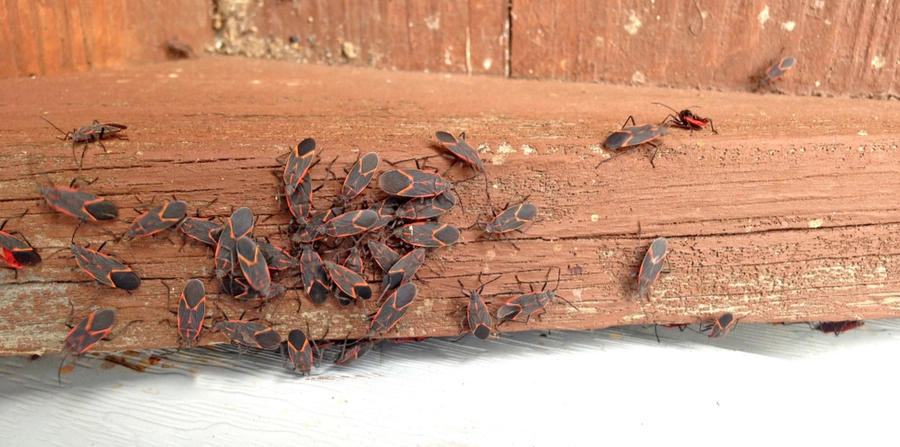
Image Credit: griffinpest
Of course, however, much you try to discourage boxelder bugs from coming to your property and breeding in your yard, some will inevitably arrive, especially if you have boxelder trees.
For this reason, you should also try to make your home inaccessible to them to prevent them from gaining access. Here’s what to do.
1. Keep doors and windows closed
When boxelder bugs are present, keep your doors and windows closed as much as possible. This will help prevent them from gaining access to your home.
2. Seal up and cracks
Of course, keeping doors and windows closed won’t keep them all out – so you’ll also need to block up any cracks and gaps through which they might gain access.
Check around your windows and under eaves and make sure there are no gaps in your walls, floors or foundations. Sealing up any gaps will help prevent them from getting into your home when the temperatures start to drop.
3. Fit door sweeps
Another gap they can get in through might be under your doors, so make sure your doors are fitted with door sweeps to stop them coming in that way.
Prevention is better than a cure
As we’ve seen, when boxelder bugs begin to swarm in spring or fall, there are a few things you can do to break up the swarms and reduce the populations, including using diatomaceous earth, spraying them with soapy water or simply vacuuming them up.
However, it’s far better to take preventative measures to reduce their populations in advance while also making your yard less attractive to them and doing everything you can to stop them getting into your home.
That way, over time, the problem you face with these bugs will become progressively easier and less troublesome to deal with.
